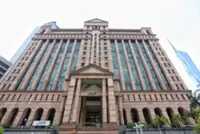FILE PHOTO: A Tesla Cybertruck drives outside of a Tesla showroom in New York City, U.S., January 2, 2025. REUTERS/Adam Gray/File Photo
(Reuters) - A crash involving a Tesla Cybertruck in self-driving mode this week has sparked worries about the reliability of the company's software that powers the feature, days after CEO Elon Musk said he would roll out a paid robotaxi service this year.
The pickup, the latest model in Tesla's lineup, failed to merge out of a lane that was ending, hit the curb and crashed into a pole in Nevada's Reno city while on its Full Self-Driving feature, which still requires a human in control behind the wheel.
"Don't make the same mistake I did. Pay attention. It is easy to get complacent now - don't," the driver Jonathan Challinger said on social media platform X tagging Musk. "Spread my message and help save others from the same fate or far worse."
The driver reported that there were unknown mechanical issues that caused the vehicle to leave the lane and hit the pole, according to a police report seen by Reuters.
Tesla has for years faced criticism and investigations over the safety of its advanced driver assistance software following several crashes, including a fatal one.
But Musk late last month said people skeptical of the technology should try it now, touting the "immense improvement" in the safety profile of its latest iteration called Version 13.
The latest Cybertruck accident - which has gone viral on social media - is a warning sign about the safety of the technology and Tesla's readiness to take the driver out, according to autonomous vehicle technology experts.
"The race is on a technology which is not ready for deployment," said Saber Fallah, professor of Safe AI and Autonomy at the University of Surrey.
"Lane endings, merges, and sudden road layout changes remain problematic for AI-driven systems, which lack the cognitive adaptability of human drivers," he said.
Tesla did not respond to a request for comment on the crash.
Musk said Tesla will start testing paid ride-hailing service by June in Austin, Texas - a state with almost no regulatory requirements for autonomous vehicles - followed by California and other U.S. regions by the end of the year.
A successful deployment of robotaxis is crucial for Tesla as it grapples with a broader slowdown in demand for its aging lineup of EVs, while investors bet heavily on Musk's pivot to robotics and AI for future growth.
Unlike other automakers, which use redundant technologies for safety, Tesla's approach relies only on cameras, making it cheaper but also riskier in challenging visibility conditions, such as heavy rain, snow or fog, according to experts.
The accident shows there are problems with FSD's nighttime detection abilities, data mapping and vision-only approach, researcher Troy Teslike, who closely tracks Tesla sales and technologies, said on X.
"FSD doesn't seem ready for driverless operation yet," he said.
(Reporting by Abhirup Roy in San Francisco and Akash Sriram in Bengaluru; Editing by Anil D'Silva)





